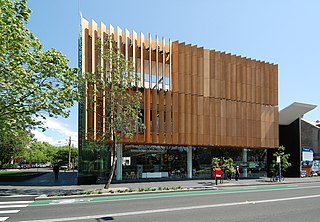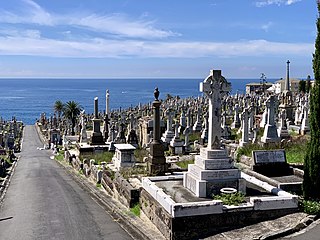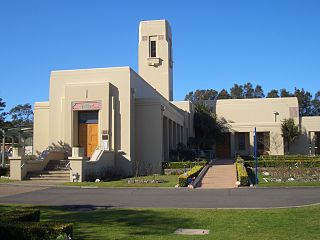
Rookwood Cemetery is a heritage-listed cemetery in Rookwood, Sydney, New South Wales, Australia. It is the largest necropolis in the Southern Hemisphere and is the world's largest remaining operating cemetery from the Victorian era. It is close to Lidcombe railway station about 17 kilometres (11 mi) west of the Sydney central business district. It was added to the New South Wales State Heritage Register on 2 April 1999.

Surry Hills is an inner-east suburb of Sydney, in the state of New South Wales, Australia. Surry Hills is immediately south-east of the Sydney central business district in the local government area of the City of Sydney. Surry Hills is surrounded by the suburbs of Darlinghurst to the north, Chippendale and Haymarket to the west, Moore Park and Paddington to the east and Redfern to the south. It is often colloquially referred to as "Surry".

Central is a heritage-listed railway station located in the centre of Sydney, New South Wales, Australia. The station is the largest and busiest railway station in Australia and serves as a major transport interchange for NSW TrainLink inter-city rail services, Sydney Trains commuter rail services, Sydney light rail services, bus services, and private coach transport services. The station is also known as Sydney Terminal. The property was added to the New South Wales State Heritage Register on 2 April 1999. It recorded 85.4 million passenger movements in 2018 and serves over 250,000 people daily.

The Waverley Cemetery is a heritage-listed cemetery on top of the cliffs at Bronte in the eastern suburbs of Sydney, New South Wales, Australia. Opened in 1877 and built by R. Watkins and P. Beddie, the cemetery is noted for its largely intact Victorian and Edwardian monuments. It is regularly cited as being one of the most beautiful cemeteries in the world. The cemetery contains the graves of many significant Australians including the poet Henry Lawson. Also known as General Cemetery Waverley, it was added to the New South Wales State Heritage Register on 28 October 2016.

Mary Reibey née Haydock was an English-born merchant, shipowner and trader who was transported to Australia as a convict. After gaining her freedom, she was viewed by her contemporaries as a community role model and became legendary as a successful businesswoman in the colony.

Rookwood is a suburb in western Sydney, in the state of New South Wales, Australia located 14 kilometres (8.7 mi) west of the Sydney central business district, in the local government area of the Cumberland Council. It is the easternmost suburb in greater western Sydney.

The Sydney Town Hall is a late 19th-century heritage-listed town hall building in the city of Sydney, the capital city of New South Wales, Australia, housing the chambers of the Lord Mayor of Sydney, council offices, and venues for meetings and functions. It is located at 483 George Street, in the Sydney central business district opposite the Queen Victoria Building and alongside St Andrew's Cathedral. Sited above the Town Hall station and between the city shopping and entertainment precincts, the steps of the Town Hall are a popular meeting place.

Brickfield Hill is a City of Sydney locality in inner city Sydney, Australia. The name was used for the surrounding settlement serving the colony's growing need for bricks, and today is part of the suburb of Surry Hills.

Eastern Suburbs Memorial Park, Eastern Suburbs Crematorium and Botany General Cemetery, is a cemetery and crematorium on Bunnerong Road in Matraville, New South Wales, in the eastern suburbs district of Sydney, Australia.

Camperdown Cemetery is an historic cemetery located on Church Street in Newtown, an inner-city suburb of Sydney, New South Wales, Australia. The cemetery was founded in 1848 and was for twenty years the main general cemetery for Sydney, with the total number of burials being about 18,000. Many people who were important to the early history of colonial Australia are buried there. It is the only one of Sydney's three main early cemeteries that still exists.

The Gore Hill Memorial Cemetery is a heritage-listed cemetery located on the Pacific Highway in St Leonards, Sydney, Australia. It was established on 19 May 1868 by the New South Wales politician, William Tunks, and is one of the oldest and most significant remaining cemeteries in metropolitan Sydney. The first interment was in 1877, and until its closure for burials in 1974, 14,456 burials took place. Most burials took place between 1900 and 1930. It is also known as the Gore Hill Cemetery. The cemetery is situated on Crown land and is managed by a not for profit community organisation, Northern Cemeteries, through a Board of Trustees. It was added to the New South Wales State Heritage Register on 25 May 2001.
John Cadman worked as a publican in England, before becoming a convict and being transported to Australia.
The Old Sydney Burial Ground is the site of Sydney's inaugural permanent cemetery, located near the current corner of George Street and Druitt Street. Established in September 1792, the cemetery was closed in 1820, when the Devonshire Street Cemetery was opened; the cemetery was deemed a threat to public health by Governor Lachlan Macquarie. Covering about 8000 square metres, the cemetery was for the entire population, convicts and free citizens alike. There were about 2,000 people buried here, however no register was kept
Balmain Cemetery was a cemetery in Leichhardt, New South Wales, Australia. The Pioneers Memorial Park now stands in its place.

St Thomas Rest Park, located in West Street, Crows Nest, New South Wales is the site of the first cemetery on Sydney's North Shore. It is the largest park in the densely populated Crows Nest area.
David Stuurman was a Khoi chief and political activist who fought against Dutch and British colonial administration. His active career as Khoi leader spanned twenty years (1799-1819) and the three Xhosa Wars which fell within this period.

The Municipality of Lidcombe was a local government area in the Western region of Sydney, New South Wales, Australia. The municipality was proclaimed as the Borough of Rookwood on 8 December 1891 and was renamed to the Municipality of Lidcombe, a portmanteau of two mayor's names, in order to differentiate itself from the expanding necropolis, from 15 October 1913. It included the modern suburbs of Rookwood, Lidcombe, Homebush Bay, Berala and parts of Newington, Silverwater, Homebush West and Regents Park. From 1 January 1949, the council was amalgamated into the Municipality of Auburn, with the passing of the Local Government (Areas) Act 1948.

The South Head General Cemetery is a heritage-listed cemetery located at 793 Old South Head Road, Vaucluse, New South Wales, Australia. It was built from 1845 to 1950. It is also known as Old South Head Cemetery and the South Head Cemetery. The property is Crown Land governed by Waverley Municipal Council. It was added to the New South Wales State Heritage Register on 25 August 2017.

Woronora Memorial Park is a cemetery in Woronora, Sydney, Australia.
















